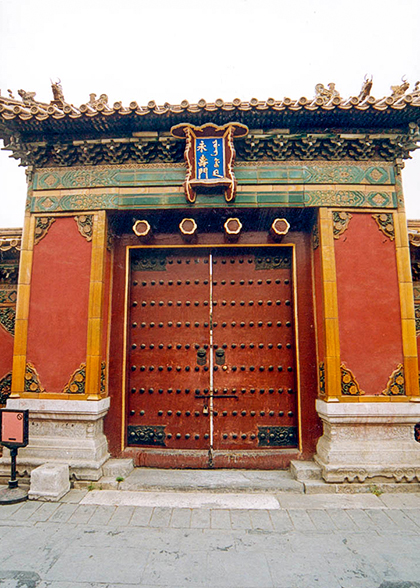Palace of Eternal Longevity (Yongshougong)
As one of the Six Western Palaces in Forbidden City, Palace of Eternal Longevity (Yongshougong) was the residence of concubines in the Ming and Qing dynasties (1368 – 1911). It also was served as the place for princesses’ marriage banquet. After the reign of emperor Guangxu, the front and back halls of Yongshougong were set as the large warehouses to store royal items. It is now the temporary cultural relics showroom of Forbidden City to hold exhibitions on various topics, including wine wares and porcelain plates.
Chinese name: 永寿宫 yong shou gong
Names used in history: Changlegong from 1420 to 1535; Yudegong from 1535 to 1616
Constructed in: 1420 in early Ming Dynasty
Repaired in: 1655, 1697, 1897 in Qing Dynasty
Location: West of inner court
Layout: Chinese character “日”
The layout of Yongshougong looks like Chinese character “日” and the front yard has a main hall with 5 rooms and yellow glazed tile roof. There is a board up the front door inscribed with Emperor Qianlong's calligraphy saying "Ling Yi Shu De", meaning proper and graceful appearance and manner. There are three side rooms on the east and west sides of the main hall.
In backyard, the main hall is right behind that of the front yard. There are three side rooms on the west and east respectively of main hall either. A well pavilion is located to the southeast of the courtyard.
In addition to being the residence of the concubines, Yongshougong was repeatedly served as a place holding banquets for female royal families when the princess got married because of its close location to Cininggong, the empress’s residence and Yangxindian, the emperor’s residence in Qing Dynasty. In the 37th year of the reign of Qing Qianlong in 1772, princess Heshuo Heke got married, and in the 54th year of the reign of Qianlong in 1789, princess Gulun Heshuo got married. Both their wedding banquets were held at Palace of Eternal Longevity.
In the middle and late period of Qing Daoguang, foreign invasion and internal aggression became more and more severe, but the court officials hid the secret reports in Yongshougong.
After the reign of Qing Guangxu, the front and rear halls of the palace were set up as warehouses to store the imperial objects.
Empress dowager Xiaomuji, the mother of Ming emperor Xiaozong, the 9th emperor of Ming, once lived in Yongshougong for a short period of time before died suddenly. People unanimously speculated that Noble Concubine Wan poisoned her to death, but the then emperor Xianzong did not investigate. So it became one of the mysterious cases in Ming dynasty.
Ming emperor Wanli, the 13th emperor of Ming, also lived in Yongshougong for a period of time after the fire burnt his residence, Qianqinggong. And in the Ming Wanli 18 years (1590), he summoned the scholars here.
He is the last emperor of Ming. In the 11 years of Ming Chongzhen in 1638, the emperor lived in Yongshougong temporarily for blessing because the domestic disaster repeatedly appeared.
Qing emperor Shunzhi's noble concubine Dong’e, once lived here for a period.
In the 13th year of the reign of emperor Yongzheng in 1735, empress dowager Chongqing, the succeeding emperor Qianlong's mother, lived in Yongshougong for some time after the death of emperor Yongzheng.
Basic Facts of Palace of Eternal Longevity
Names used in history: Changlegong from 1420 to 1535; Yudegong from 1535 to 1616
Constructed in: 1420 in early Ming Dynasty
Repaired in: 1655, 1697, 1897 in Qing Dynasty
Location: West of inner court
Layout: Chinese character “日”
What to See inside Yongshougong
 |
In backyard, the main hall is right behind that of the front yard. There are three side rooms on the west and east respectively of main hall either. A well pavilion is located to the southeast of the courtyard.
What was Palace of Eternal Longevity (Yongshougong) used for?
In the middle and late period of Qing Daoguang, foreign invasion and internal aggression became more and more severe, but the court officials hid the secret reports in Yongshougong.
After the reign of Qing Guangxu, the front and rear halls of the palace were set up as warehouses to store the imperial objects.
Who Had ever Lived Here?
1. Empress dowager Xiaomuji (1451 - 1475)
2. Emperor Wanli ( 1563 - 1620)
3. Emperor Chongzhen (1628-1644)
4. Noble concubine Dong’e (1639 - 1660)
5. Empress dowager Chongqing (1693 -1777)
See more Six Western Palaces
- Last updated on Sep. 26, 2024 by Gabby Li -